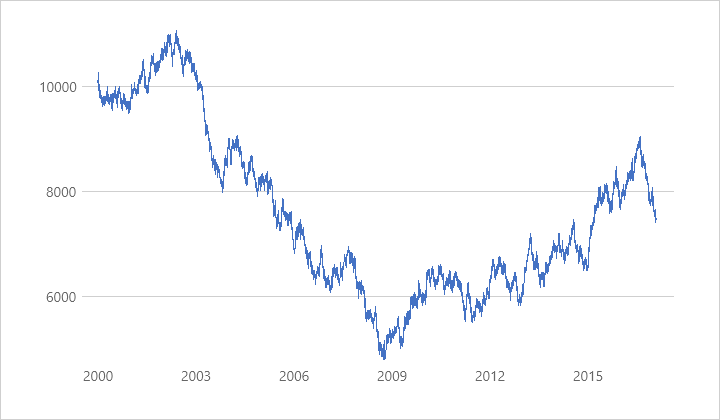Series.Data Property
Gets or sets an object that defines how data should be supplied for this series.
Namespace: DevExpress.WinUI.Charts
Assembly: DevExpress.WinUI.Charts.v22.1.dll
NuGet Package: DevExpress.WinUI
Declaration
Property Value
| Type |
|---|
| DataSourceBase |
Remarks
For more information, refer to Providing Data.
Example
The following example demonstrates how to bind a chart to data from a ViewModel.

To do this, it is necessary to assign the DataSource object to the Series.Data property and specify the data source for the adapter in its DataSource.PointSource property.
<Window
x:Class="DataSourceExample.MainWindow"
xmlns="http://schemas.microsoft.com/winfx/2006/xaml/presentation"
xmlns:x="http://schemas.microsoft.com/winfx/2006/xaml"
xmlns:local="using:DataSourceExample"
xmlns:d="http://schemas.microsoft.com/expression/blend/2008"
xmlns:mc="http://schemas.openxmlformats.org/markup-compatibility/2006"
xmlns:Charts="using:DevExpress.WinUI.Charts"
mc:Ignorable="d">
<Grid>
<Charts:CartesianChart x:Name="chart">
<Charts:Series>
<Charts:Series.View>
<Charts:LineSeriesView/>
</Charts:Series.View>
<Charts:Series.Data>
<Charts:DataSource PointSource="{Binding ItemsSource}"
ArgumentDataMember="PointArgument"
ValueDataMember="PointValue"/>
</Charts:Series.Data>
</Charts:Series>
<Charts:CartesianChart.AxisX>
<Charts:AxisX DateTimeGridAlignment="Year"
DateTimeMeasureUnit="Hour"
LabelPattern="{}{V:yyyy}"/>
</Charts:CartesianChart.AxisX>
</Charts:CartesianChart>
</Grid>
</Window>
using Microsoft.UI.Xaml;
using System;
using System.Collections;
using System.Collections.Generic;
namespace DataSourceExample {
public sealed partial class MainWindow : Window {
public MainWindow() {
this.InitializeComponent();
chart.DataContext = new ViewModel() {
Start = 10000,
Count = 50000,
Step = TimeSpan.FromHours(3),
};
}
}
public class DateTimeDataPoint {
public DateTime PointArgument { get; set; }
public double PointValue { get; set; }
}
public class ViewModel {
DateTime start = new DateTime(2000, 1, 1);
IEnumerable itemsSource;
readonly Random random = new Random();
public TimeSpan Step { get; set; }
public int Count { get; set; }
public double Start { get; set; }
public IEnumerable ItemsSource {
get { return itemsSource ??= CreateItemsSource(Count); }
}
protected IEnumerable CreateItemsSource(int count) {
var points = new List<DateTimeDataPoint>();
double value = GenerateStartValue(random);
points.Add(new DateTimeDataPoint() { PointArgument = start, PointValue = value });
for (int i = 1; i < count; i++) {
value += GenerateAddition(random);
start += Step;
points.Add(new DateTimeDataPoint() { PointArgument = start, PointValue = value });
}
return points;
}
protected double GenerateStartValue(Random random) {
return Start + random.NextDouble() * 100;
}
protected double GenerateAddition(Random random) {
double factor = random.NextDouble();
if (factor == 1)
factor = 50;
else if (factor == 0)
factor = -50;
return (factor - 0.5) * 50;
}
}
}
See Also